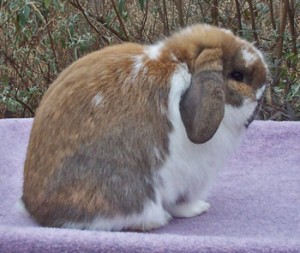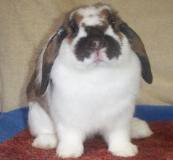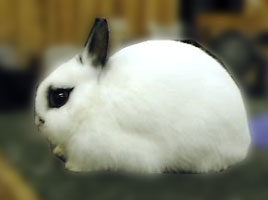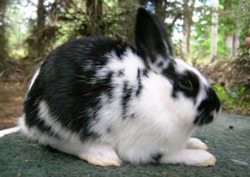The breeds that carry the dwarf gene are the Holland Lop, Netherland Dwarf, Mini Rex, Mini Satin, Dwarf Hotot, Polish, Britannia Petite, American Fuzzy Lop, and Jersey Wooly. This article is written for Holland Lops, but the principles apply to all dwarf breeds. Some of the smallest breeds that don’t carry the dwarf gene are Himalayans, Dutch, Florida Whites, Mini Lops, and Tans.
How can you avoid the fatal peanuts and still produce show-winning bunnies?
Successful Holland Lop breeder Laurie Stroupe shares her knowledge.
Please note that “false dwarf” and “normal” are the same and the terms may be used interchangeably.
In dwarf breeds, there’s no way to produce more than 50% true dwarfs, on the average. No matter how clever you are at matching rabbits, no matter how high the quality of your herd, no matter how typey your rabbits are, fifty-percent is the max.

We are limited by biology. Each true dwarf carries a dwarf gene and a normal gene (a false dwarf gene). When you breed two true dwarfs together, you get, on the average, 50% true dwarfs, 25% false dwarfs, and 25% peanuts. Sure, you can get an all-true-dwarf litter occasionally, especially in smaller litters. But I’m talking about on the average. You can also get six peanuts in a litter. But that’s atypical, too. If you look back over your last 100 births from true dwarf to true dwarf breedings, you should see approximately 50%, 25%, and 25% – true, false, and peanuts.
But it seems like you are getting more show quality rabbits than that? Does it now. Well, that’s probably because we are usually more concerned with the surviving litter. In the surviving litter (taking into consideration that peanuts always die), you have 50% true and 25% false (or normal), of the original litter. That’s a 2 to 1 ratio. In other words, about 2/3 of the surviving litter will be true dwarf and 1/3 of the surviving litter will be false.
So, does that mean you don’t get as many true dwarfs – the ones with the show potential – when you breed true dwarf to false dwarf. No. You get the same number of true dwarfs – 50% of births. The false dwarf, or normal parent, only has a normal gene to contribute to each offspring. The true dwarf parent gives the normal gene to half and the true dwarf gene to half. So the result is 50% true dwarf and 50% false dwarf, or normal kits.
Notice that you still get 50% true dwarf kits. It’s not less. It’s exactly the same.
The difference here is that, instead of 25% peanuts, you get an additional 25% false dwarfs.
Is that a good thing or a bad thing? Well, it depends. For producing show quality rabbits, it’s a total wash, percentage-wise. But for feeding normal kits that will, at best, be brood animals, that may not be beneficial to your program. If you can sell brood does well, it may be a good thing for you. If you have brisk pet sales and can move out big beautiful bucks easily, it might be a way to help pay your feed bill. If you tend to end up with excess false dwarfs on hand, it may not be a good plan for you.

If you suffer when you see peanuts die, you might want to avoid true to true breedings altogether. It won’t reduce your ability to produce show quality animals.
I should mention that another downside to breeding true to false is that the false dwarf rabbits are much more difficult to evaluate. A true dwarf shows you his or her characteristics in true dwarf form. But with a false dwarf, you are having to extrapolate what you think that rabbit would be like as a true dwarf. Perhaps you attribute the length of ear to the false dwarfness, and you’d often be right. But it may be that his or her ears would still be longer than you like in the true dwarf version as well.
Or you may love the bone or head mass on a false dwarf rabbit, hoping it will pass that characteristic down to its offspring. But then you find that only the false dwarf kits get those characteristics.
On the other hand, I have a false dwarf doe that has produced at least one, usually two, and sometimes more show quality bunnies in each of her litters. She does pass down her heavy bone. And my rabbit with the most legs in my barn has a false dwarf sire.

There can be a distinct advantage to breeding true dwarf to false dwarf, though, when the false dwarf is a doe. If she produces large litters, say six per litter, that means she’s producing, on the average, three true dwarfs per litter. If your true dwarf doe produces four kits per litter, that’s just two true dwarfs per litter. Sure, there are true dwarfs that produce seven kits each time and false dwarfs that produce one or two, but I’ve found that most often my biggest producers – and the ones that can recover well and be ready to breed again – are the false dwarfs.
In my first two years as a breeder, I had 112 breedings that produced kits. In 41 of the breedings, the dams were false dwarfs and in 71, they were true dwarf. The false dwarfs produced 5.05 kits per litter, on the average, and the true dwarfs produced 4.15 kits per litter, on the average.
That’s like getting one bonus true dwarf every other litter. And that doesn’t consider that she may produce several more litters during her lifetime than her true dwarf counterpart because she holds her condition between litters better.
As a side note, 66% of my home grown grand champions have a false dwarf parent.
No discussion of true dwarfs and false dwarfs would be complete without mentioning that, if you breed two normals together, you only get normals. Or, two false dwarf brood animals bred together cannot produce a true dwarf, typey, show rabbit.

